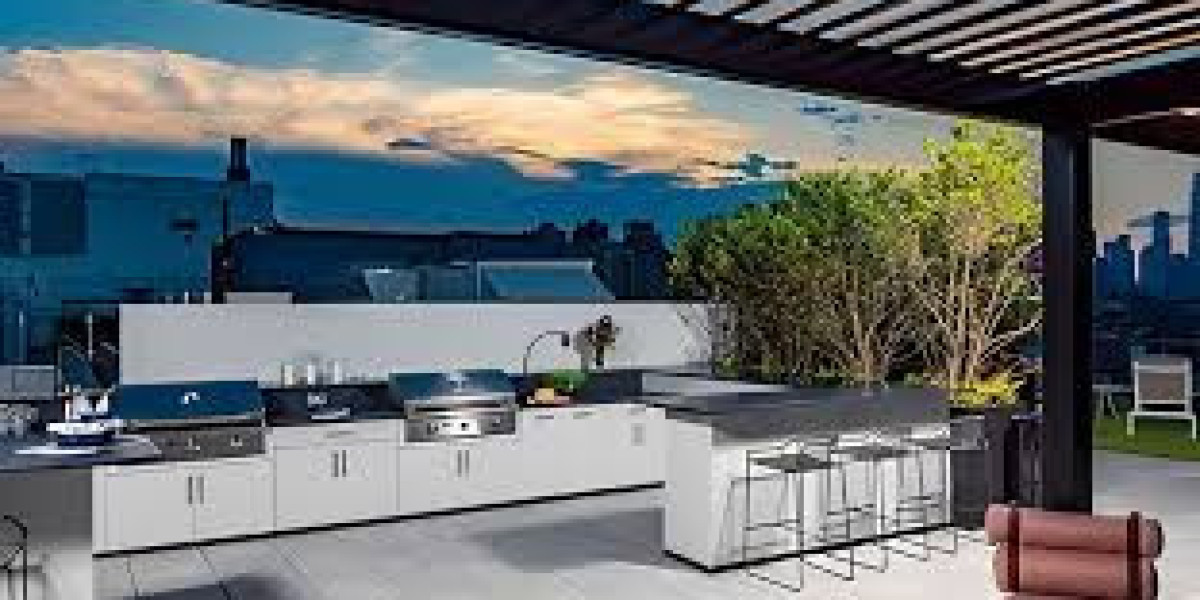In recent years, outdoor kitchens have gained immense popularity among homeowners looking to enhance their outdoor living spaces. These versatile and functional areas allow for al fresco dining, entertaining guests, and enjoying the great outdoors while preparing delicious meals. In this article, we will explore the many benefits of outdoor kitchens, the essential elements to consider when designing one, and tips for maintaining your outdoor culinary space.
The Allure of Outdoor Kitchens
1. Expanding Living Space
One of the most appealing aspects of an outdoor kitchen is the additional living space it provides. Homeowners can seamlessly extend their indoor living areas to the outside, creating a versatile environment for cooking, dining, and relaxing. Whether it’s a small balcony, a spacious patio, or a sprawling backyard, an outdoor kitchen can transform any space into a multifunctional oasis.
2. Entertaining Made Easy
Outdoor kitchens are ideal for entertaining friends and family. They provide a natural gathering place where guests can socialize while the host prepares meals. With the right setup, an outdoor kitchen allows for a seamless flow between cooking and dining, making it easier to serve food and drinks without the hassle of running in and out of the house.
3. Connection to Nature
Cooking outdoors allows homeowners to enjoy the beauty of nature while preparing meals. The fresh air, sunlight, and scenic views can enhance the cooking experience and create a relaxing atmosphere. Whether it’s a cozy summer evening or a sunny afternoon, outdoor kitchens provide a unique environment that indoor kitchens simply cannot replicate.
4. Increased Home Value
Investing in an outdoor kitchen can significantly increase the value of your home. Many prospective buyers are drawn to homes with outdoor living spaces, especially those equipped with kitchens. A well-designed outdoor kitchen can set your home apart in a competitive real estate market, making it a wise investment for homeowners looking to enhance their property’s appeal.
Key Components of an Outdoor Kitchen
1. Grill or Cooking Appliance
At the heart of any outdoor kitchen is the grill or cooking appliance. Depending on your cooking preferences, you may choose a traditional gas or charcoal grill, a built-in barbecue, or even a pizza oven. Consider the types of meals you enjoy preparing and select an appliance that suits your culinary style.
2. Countertops and Prep Space
Adequate countertop space is essential for food preparation and serving. Materials like granite, quartz, or stainless steel are popular choices for outdoor countertops due to their durability and resistance to the elements. Incorporating an island or bar area can provide additional seating and enhance the overall functionality of your outdoor kitchen.
3. Storage Solutions
Storage is crucial in an outdoor kitchen to keep cooking tools, utensils, and supplies organized. Cabinets made from weather-resistant materials can help protect your belongings from moisture and pests. Additionally, consider incorporating a pantry or shelves for easy access to ingredients and condiments.
4. Sink and Plumbing
Having a sink in your outdoor kitchen adds convenience for cleaning dishes and preparing food. A sink connected to a water supply will make your cooking experience more efficient. Ensure proper drainage is installed to avoid water pooling around your kitchen area.
5. Lighting
Outdoor kitchens can be used day or night, so adequate lighting is essential for both functionality and ambiance. Incorporate task lighting over cooking areas and ambient lighting to create a warm and inviting atmosphere. String lights, lanterns, or built-in LED fixtures can enhance the overall aesthetic.
6. Seating Arrangements
Comfortable seating is key to making your outdoor kitchen a welcoming space. Consider various options, such as bar stools at the counter, dining tables for larger gatherings, or cozy lounge chairs for relaxation. Ensure that the seating is weather-resistant and complements the overall design of your kitchen.
Design Considerations
When designing your outdoor kitchen, several factors should be taken into account:
1. Space and Layout
Assess the available space in your yard and determine the best layout for your outdoor kitchen. Consider the flow of movement between different areas, including cooking, dining, and relaxation zones. Ensure there is enough room for guests to move around comfortably without feeling cramped.
2. Weather and Climate
Your local climate will influence the materials and design of your outdoor kitchen. In areas with harsh winters, consider adding features like a pergola or awning for protection from snow and rain. In warmer climates, shade structures can help keep the kitchen cool during the hottest months.
3. Style and Aesthetics
Your outdoor kitchen should complement the overall style of your home and garden. Choose materials, colors, and designs that harmonize with your existing landscape and architecture. A cohesive look will enhance the overall appeal of your outdoor space.
4. Budget
Establishing a budget is crucial when planning your outdoor kitchen. Costs can vary significantly based on the materials, appliances, and features you choose. Research and compare prices to ensure you stay within your budget while still achieving the desired outcome.
Maintenance Tips for Outdoor Kitchens
To keep your outdoor kitchen in top condition, regular maintenance is essential. Here are some tips to help you care for your outdoor culinary space:
1. Clean Regularly
After each use, clean the grill and cooking appliances to prevent grease buildup and maintain optimal performance. Wipe down countertops and surfaces to remove food particles and spills. Regular cleaning will help prolong the life of your outdoor kitchen.
2. Protect from the Elements
Invest in protective covers for your appliances and furniture when not in use. This will help shield them from rain, snow, and UV rays, preventing wear and tear over time. Additionally, consider using a sealant on stone or wooden surfaces to enhance durability.
3. Inspect Plumbing and Electrical Systems
If your outdoor kitchen includes plumbing or electrical components, schedule regular inspections to ensure everything is functioning properly. Address any leaks or malfunctions promptly to prevent more significant issues down the line.
4. Seasonal Maintenance
At the beginning of each season, perform a thorough check of your outdoor kitchen. Clean the grill, inspect appliances, and check for any weather-related damage. Preparing your kitchen for seasonal changes will help maintain its functionality and appearance.
Conclusion
Outdoor kitchens are more than just a trend; they represent a lifestyle choice that embraces the joys of cooking and entertaining in the great outdoors. With careful planning, thoughtful design, and regular maintenance, you can create a beautiful and functional outdoor kitchen that enhances your home and provides countless memories for years to come. Whether you’re hosting a summer barbecue or enjoying a quiet dinner under the stars, your outdoor kitchen can become the heart of your home, offering a unique space for culinary creativity and connection with loved ones.








